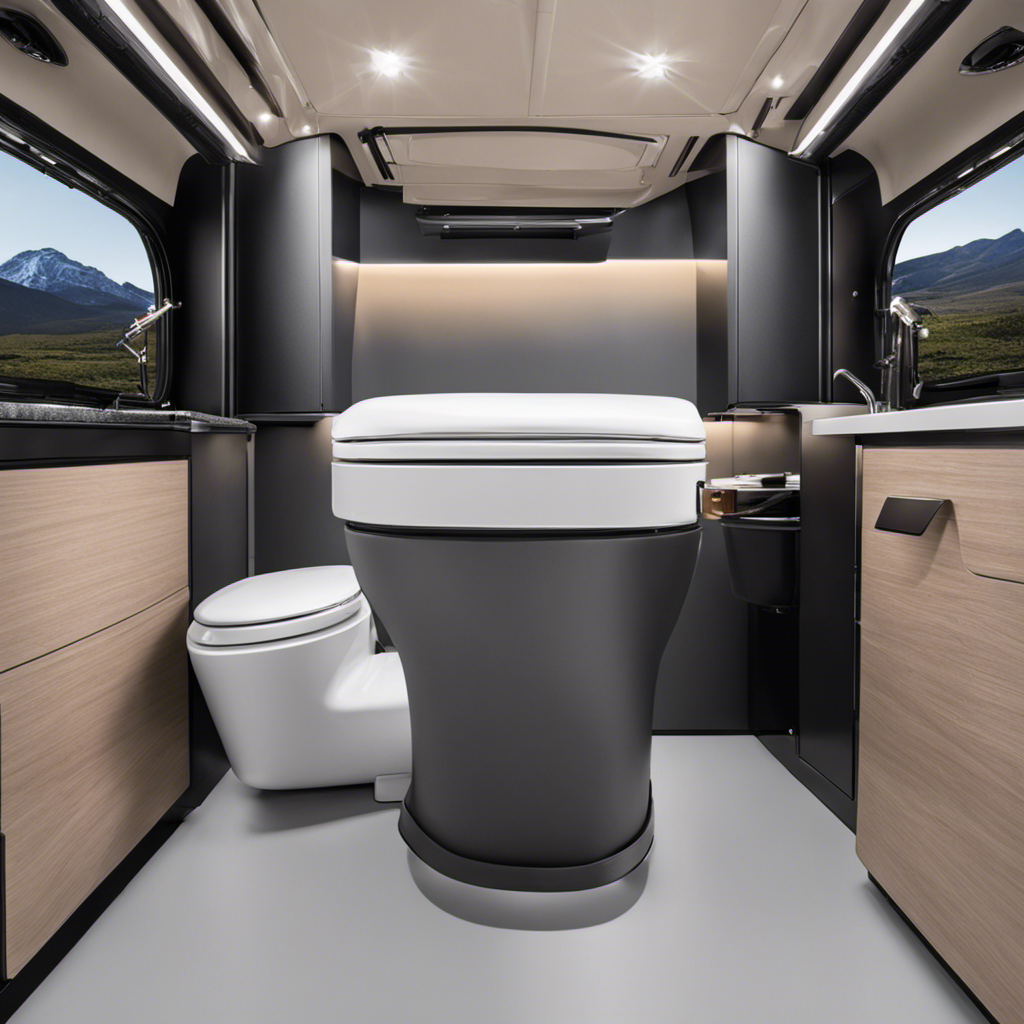As an avid RV enthusiast, I’ve always been curious about how an RV toilet actually works. So, I decided to delve into the inner workings of this essential piece of equipment.
In this article, I will break down the anatomy of an RV toilet, explain the flushing mechanism, delve into the role of water, and provide tips for proper maintenance and cleaning.
Get ready to dive into the technical details and discover the fascinating world of RV toilets.
Key Takeaways
- An RV toilet consists of a durable plastic bowl, a flush mechanism, and a seal to prevent leakage.
- Water is essential for flushing waste and maintaining cleanliness in an RV toilet.
- Excessive water usage in RV toilets can have environmental consequences, making water-saving features important.
- Waste management in RV toilets can involve composting toilets, alternative toilet options, or holding tanks for proper disposal.
The Anatomy of an RV Toilet
An RV toilet is made up of several key components that work together to efficiently dispose of waste.
The main parts of an RV toilet include the bowl, flush mechanism, seal, and waste tank.
The bowl is where the waste is collected and it is usually made of durable plastic.
The flush mechanism is responsible for bringing in water to rinse the bowl and carry away the waste. It is controlled by a foot pedal or a lever.
The seal ensures that there is no leakage between the bowl and the waste tank.
To unclog an RV toilet, you can try using a plunger or a specialized RV toilet auger.
It is important to follow the manufacturer’s instructions and use gentle, consistent pressure to avoid damaging the toilet.
Understanding the Flushing Mechanism
The flushing mechanism in an RV toilet uses water pressure to remove waste. It is a simple yet effective system that ensures proper sanitation and hygiene while on the road.
Here are three key components of the flushing mechanism:
-
Water Supply: The toilet bowl is connected to the RV’s freshwater supply. When the flush lever is activated, water flows into the bowl, creating a strong force of water.
-
Flush Valve: The flush valve is located at the bottom of the toilet bowl. When the flush lever is pushed, the valve opens, allowing water to rush into the bowl and carry away the waste.
-
Wastewater Disposal: Once the waste is flushed, it travels through the RV’s plumbing system and into the holding tank. The wastewater can then be disposed of at an appropriate facility when the tank is full.
Understanding the flushing mechanism is essential for proper operation and maintenance of an RV toilet.
The Role of Water in RV Toilets
To ensure proper functionality, you should understand how water plays a crucial role in RV toilets. Water usage is an important aspect of RV toilet systems, as it is responsible for flushing waste and maintaining cleanliness. The amount of water used during each flush can vary depending on the type of toilet and the user’s preference. However, it is important to note that excessive water usage can have an environmental impact, especially when using RVs in remote areas with limited water supply. To minimize water usage and its environmental impact, many RV toilets are equipped with water-saving features such as adjustable flush settings and low-flow mechanisms. These features help conserve water without compromising the toilet’s performance. By being mindful of water usage and using water-saving features, RV owners can reduce their environmental footprint and contribute to sustainable camping practices.
| Pros of Water Usage in RV Toilets | Cons of Water Usage in RV Toilets |
|---|---|
| Efficient waste removal | Environmental impact |
| Maintains cleanliness | Limited water supply |
| Prevents odors | Excessive water consumption |
| Easy to use and maintain |
Managing Waste in an RV Toilet
Managing waste in an RV toilet involves understanding the proper disposal methods and utilizing waste management systems. To ensure efficient waste management, consider the following:
-
Composting Toilets: These eco-friendly alternatives break down waste into compost, eliminating the need for water and sewage systems.
-
RV Toilet Alternatives: There are various options available, such as cassette toilets or portable toilets, which allow for easy waste removal and disposal.
-
Waste Management Systems: Many RVs are equipped with holding tanks that collect waste until it can be properly disposed of at designated dump stations.
By implementing these waste management solutions, RV owners can effectively handle waste disposal while minimizing environmental impact.
Transitioning into the subsequent section about tips for proper maintenance and cleaning, it is crucial to understand the importance of regular maintenance to ensure the longevity and functionality of the RV toilet.
Tips for Proper Maintenance and Cleaning
Implementing regular maintenance and cleaning is essential for ensuring that an RV toilet functions properly and lasts for a long time. To prevent odors and keep the toilet in top condition, it is important to choose the right cleaning products.
When cleaning the toilet bowl, use a mild cleaner specifically designed for RV toilets. Avoid using harsh chemicals or abrasive cleaners, as they can damage the toilet’s seals and components.
Additionally, regularly clean the flushing mechanism, including the flush valve and seal, to ensure proper functioning. To prevent odors, use RV-specific toilet chemicals that break down waste and neutralize odors. These chemicals can be added directly to the toilet bowl or to the holding tank.
Conclusion
In conclusion, the RV toilet is not just a mere restroom fixture, but a symbol of independence and freedom on the open road. Its intricate anatomy and flushing mechanism work harmoniously, ensuring efficient waste management.
Water, the life-giving force, plays a crucial role in keeping the system clean and odor-free. To maintain its functionality, regular maintenance and cleaning are essential.
So, embrace the symbol of the RV toilet, for it represents the power to explore, adventure, and create unforgettable memories on your journey.










